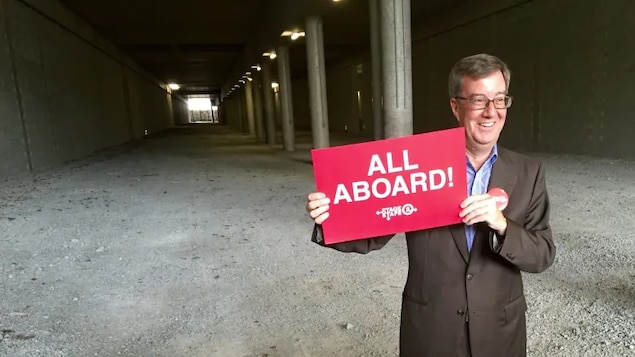It was a key question posed on Wednesday by one of the lead solicitors, John Adair, to the former deputy city manager, Nancy Schepers.
John Adair noted that a 2009 report presented to council by Ms. Schepersan engineer, says the $2.1 billion figure was a preliminary estimate that could go up, or down, by up to 25% as more details were confirmed.
However, when Jim Watson began campaigning on the $2.1 billion cost, the symbolism of that figure grew, Adair argued.
What I mean is that Mr. Watson […] and the other board members who campaigned on the $2.1 billion cost — on time and on budget — were promising the public what you, as a seasoned professional, weren’t prepared to promise the public. advice, right?
Mr. Adair asked Nancy Schepers.
In the absence of estimates, I agree
she replied.
Nancy Schepers also told Me Adair that she was not too disturbed by Jim Watson’s political mantras that she had already heard. It’s not the first time this has happened
she said.
” And you know, as staff, we report to the board. And if that was unrealistic and we said at some point, “You know, that’s not possible,” then we had to do our homework and justify that in front of the committee and the board. »
Review the first decisions of the City
The first three days of the inquiry, which spans four weeks, revealed a number of fundamental themes that the commission seems intent on examining, including whether budgets and timelines have been unduly constrained by political considerations or whether details of the public-private partnership (PPP) contract failed.
The survey repeatedly heard that the budget cap could be a problem. A number of key informants expressed concern that no company would bid at this price.
On Tuesday, another commission lawyer asked the former city treasurer if there had been any talk that price caps could cause businesses to promise too much
in order to stay within budget.
Investigating attorneys sought to determine whether the city’s decisions — made before the contract was even awarded — contributed to the Confederation Line’s problems. One of them: that of opting for a PPP in its contract with the Rideau Transit Group (GTR).
The investigation revealed that the Confederation Line project was the first in Ontario where a funding model PPP was used for a municipal light rail project.
That’s why provincial officials – including Jim Watson, who had just left the Ontario Liberal Party cabinet in late 2009 – wanted Infrastructure Ontario to advise the City on setting up the contract.
Among the key elements of the model PPP in the public transit sector, the company selected is responsible for designing, building and maintaining the system, in addition to assuming part of the financing.
In the case of the Confederation Line contract, the GTR received $300 million in private funding, which the City was to repay as part of its monthly fee payments for the 30-year maintenance contract.
This private financing is, in fact, more expensive for the City, since a municipality can generally borrow money at a much lower rate than businesses. In 2012, the City estimated it would have to pay $165 million more in interest over 30 years than if it had borrowed the money itself.
The investigation also revealed Wednesday that in May 2011 the city was not considering including private financing in its contract unless other levels of government paid for the additional costs. This did not happen, but the City still opted for a design-build-finance-maintain model.
Even if it costs the City more, supporters of PPP claim that private financing is an added incentive for the company to complete the project on time, as payments do not begin until the project is delivered. The arrangement is intended to create a tension
which encourages companies to respect the project schedule.
However, Adair argued that with a project over a year behind schedule, the model PPP deprived the GTR much-needed cash. Until it delivers the light rail system, the GTR didn’t get its final payment of more than $200 million, as the costs — including $300 million in debt servicing — kept piling up.
the GTR was under enormous financial pressure because of this model
Mr. Adair told Nancy Schepersthus suggesting that the consortium was kill financially
.
Mrs Schepers refuted this assertion by arguing that the partners of the GTR (i.e. SNC-Lavalin, ACS Infrastructure and Ellis Don) were big players in the industry who should have known what they were doing.
Nevertheless, Mr. Adair continued, the GTR could not afford to postpone the delivery date of the project, but at the same time, he could not ask the City not to execute the contract, since it is not not an option
in the PPP.
The guiding principle must always be to determine what is in the best interest of the people of Ottawa, no matter what the contract says.
suggested Me Adair to Nancy Schepers.
It is not the first time this week that commission lawyers have suggested that the City’s upholding of the contract – or at least its enforcement in the strictest sense of the word – has harmed not only to the partners of GTRbut also to the people of Ottawa.
On Friday, the former chairman and CEO of GTRAntonio Estrada, will testify, among other things, on the way the City managed the Rideau Street hole.
Thursday, it is expected that Yves Declercq of Alstom and Manuel Rivaya of OLRT Constructors testify at these public hearings.
With information from Joanne Chianello of CBC News
Reference-ici.radio-canada.ca
